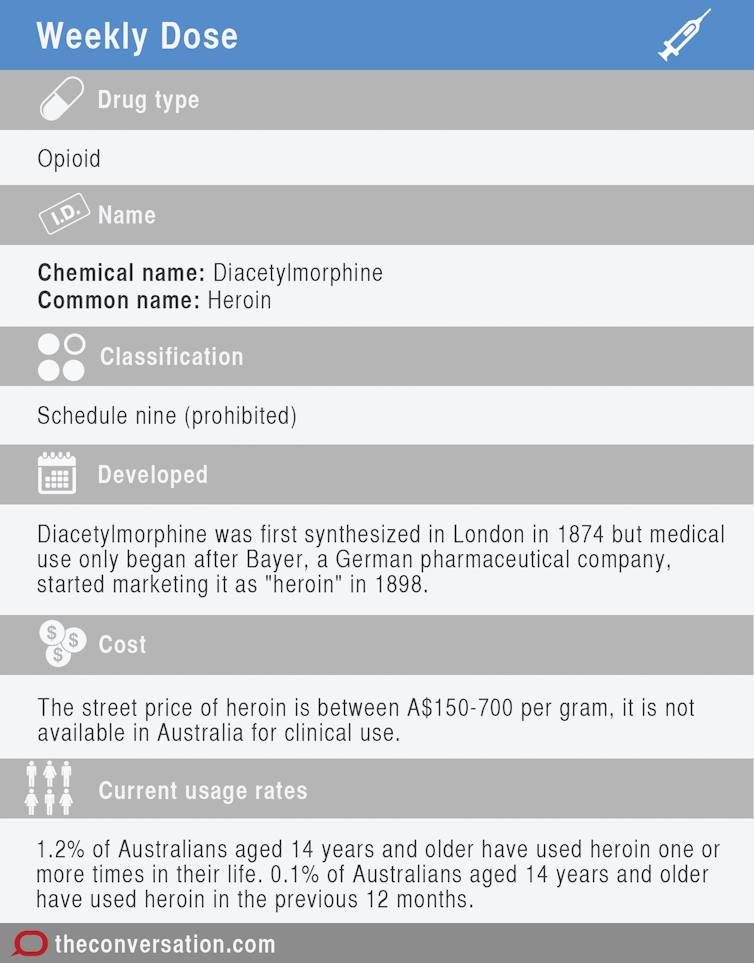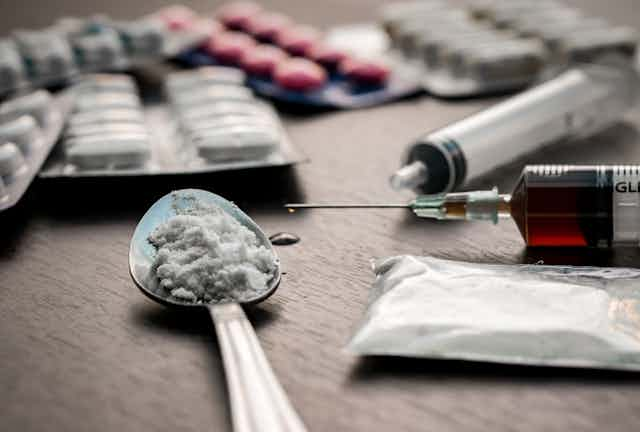Heroin, or diacetylmorphine, is made from opium poppies by first extracting morphine and then adding two molecules (acetyl) to each morphine molecule. Heroin was used medically in Australia for pain relief and other ailments but after the government banned its production and importation in 1953, heroin stocks in the states and territories were used up and could not be replenished.
After diacetylmorphine attaches to opioid receptors in the brain, the central nervous system (brain) is depressed resulting in slower breathing, less pain and slower activity in the gastro-intestinal system (constipation). Users feel euphoria and reduced anxiety.

Opioid dependence
In a frequently cited paper from 2010, 20 drugs were ranked on 16 measures of harm to users and to society. Heroin was ranked the most harmful drug for individuals but alcohol was ranked as the most harmful drug for communities, followed by heroin (alcohol was ranked the most harmful drug overall).
The World Health Organization estimates that internationally, 69,000 people die from an opioid overdose every year. Most of these deaths will be due to heroin.
Heroin use in Australia has been rising for some years and this may reflect increasing opium production in Myanmar (formerly Burma), the source of most of the heroin reaching Australia. Opium cultivation there almost doubled from 330 tonnes in 2009 to 647 tonnes in 2015.
Pharmaceutical heroin
Supervised injectable heroin treatment, also known as “heroin assisted treatment” is used to treat addiction to heroin by providing a safer alternative. Developed in Europe in the 1990s, it involves high doses of medical grade heroin, self administered by intravenous injection under close supervision.
It’s often accompanied by oral methadone (a long-acting opioid) to prevent symptoms of heroin withdrawal from developing (the effects of heroin wear off after three to four hours, but methadone lasts longer), and intensive counselling.
Pharmaceutical heroin is the same chemical compound as street heroin, except it is made by the pharmaceutical industry, which means it is high quality and purity, and its concentration is known and consistent. This is crucial to knowing what the dose should be. It is also sterile, meaning it doesn’t contain micro-organisms or chemical adulterants like street heroin.
Patients who meet the strict selection criteria attend a clinic at least once a day where they intravenously inject themselves with pharmaceutical grade heroin under observation by health-care staff.
Supervised injectable heroin treatment is regarded as a “second line” treatment, only offered to carefully selected patients with very severe problems after other treatments have been tried with disappointing results.
Supervised injectable heroin treatment is usually required for several years. Patients can increase or decrease their dose (within prescribed limits), and heroin cannot be taken out of the clinic.
How much is heroin used?
In Australia, 1.2% of those aged 14 years and older have used heroin one or more times in their life. While 0.1% of Australians aged 14 years and older have used heroin in the previous 12 months.
Supervised injectable heroin treatment is currently provided to about 2,500 people in eight countries (Switzerland, the Netherlands, Germany, Spain, Canada, United Kingdom, Denmark and Belgium). Despite the strength of evidence showing it is effective for people with severe addictions for whom other treatments haven’t worked, and that it’s relatively safe and cost effective, uptake of this treatment by new countries has been slow.

How was it developed?
Switzerland undertook a randomised controlled trial in the 1990s comparing injectable heroin with methadone treatment. This trial found supervised injectable heroin led to an improvement in health including mental health, less crime and illegal income, reduced drug expenses, and improved social functioning which the researchers (and the subjects) thought was worthwhile. This led to further trials in the Netherlands, Germany, Spain, Canada, and the United Kingdom with steadily improving designs.
By 2015, randomised controlled trials had been conducted in six countries involving 1,500 patients over 15 years. An international review of these trials in 2015 found pharmaceutical heroin treatment is effective and safe.
Benefits include improvements in physical and mental health, social functioning and reduced use of street drugs. Belgium also recently reported a small trial in 2015.
Cost
The price for a gram of heroin in Australia in 2013–14 ranged between A$150 and A$700.
Supervised injectable heroin treatment is more expensive than standard methadone treatment. In Britain, patient and government costs of providing heroin treatment over 26 weeks are £8,995 (A$17,790).
Patients, especially this group, cannot afford to pay the cost of this treatment. However several studies have shown savings from supervised injectable heroin treatment generally exceed costs, mainly through a reduction in crime but also through reduced health-care costs.
Side effects
The risk of death during supervised injectable heroin treatment is low and similar to the risk of death in methadone treatment. There is a much higher risk of death among people using street heroin. Side effects such as respiratory depression and epileptic seizures occurring after injection are more common in patients receiving supervised injectable heroin treatment than methadone treatment but the risks are considered acceptable given the benefits.
It is generally agreed that supervised injectable heroin provides considerable individual and community benefits while reducing harm compared to unsupervised street heroin supplied by the black market. Some suggest this means it is not the pharmacological properties of heroin responsible for the considerable harm to people who use the drug but mainly the black market distribution system.
Some argue that as the population suitable for this treatment represents only a tiny minority of heroin users, the treatment adds little. But others argue treating this minority effectively benefits them and the community because this small minority accounts disproportionately for harm experienced by the community.

